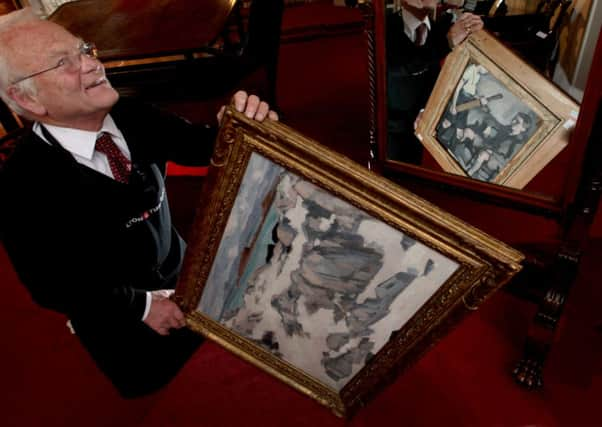‘Secret’ Samuel John Peploe painting for auction


The front of the canvas is a working of one of Peploe’s favourite haunts, the island of Iona, while on the reverse Peploe’s sons William and Denis, the younger of whom who went on to follow in his father’s footsteps as an artist, pose in their school uniforms with the bat.
CONNECT WITH THE SCOTSMAN
• Subscribe to our daily newsletter (requires registration) and get the latest news, sport and business headlines delivered to your inbox every morning
It was found by chance, only in June.
Advertisement
Hide AdNick Curnow, painting specialist at auctioneers Lyon and Turnbull, described it as “unique”.
He said: “To have not only one but two Peploe paintings on the same canvas is something rather unique.
“The other thing I find incredible about Peploe’s work is its accuracy, you can still go the beach on Iona and find the exact spot Peploe set up his easel.
“What makes these Iona paintings so successful is that whilst taking such care with the unchanging topography, Peploe has also conveyed the sense of shifting waters, rolling clouds and the crisp northern light.
“You can almost feel the sea breeze.
“But one thing that makes this painting so special is the fact that on its rear is a very personal painting of his two sons holding a cricket bat.”
The piece, which comes from a private Scottish owner, depicts a view of Eilean Annraidh with Treshnish Point in the distance, is expected to sell for up to £60,000.
Advertisement
Hide AdThe work, with the unseen painting on the reverse side, had hung on the wall of a Scottish family’s home for decades. It first discovered in June, when the family took the painting off the wall to see a board pinned to the rear of the canvas.
When the board was gently removed it revealed an entirely different and never before seen painting of William and Denis Peploe, posing in their Edinburgh Academy uniforms.
Advertisement
Hide AdThe discovery stunned Denis’s son, Guy Peploe, the artist’s grandson, who now runs an Edinburgh art gallery and had been handed the £90,000 painting by its owners to prepare for sale.
Mr Peploe, who runs The Scottish Gallery in Dundas Street, said the painting was “intriguing” and “one of a kind.”
He said: “Seeing this painting of my father and my uncle, which we didn’t know was there, was incredible,
“It is actually the only painting I have ever seen of my father by SJ Peploe.
“It was on display at my gallery in July and for whatever reason did not sell.
“I wish the family all the best with the auction.”
The “two for the price of one” artwork provides a unique glimpse into the world of the acclaimed turn of the century Scottish post-Impressionist, one of the four major talents who became known as the Scottish Colourists.
Advertisement
Hide AdFor it reveals Peploe’s prudent streak in “recycling” his canvas and keen eye for what would appeal to buyers.
Guy People added: “My grandfather must have done this painting of my father Denis and Uncle Willie, which is actually a lovely composition, and then perhaps thought, ‘is anyone going to be interested? Perhaps not,
Advertisement
Hide Ad“He might then turn it around so there’s a new unpainted canvas and start all over again.
“Sometimes a board is put on to protect a picture while it is being transported,
“You wouldn’t look at a board on the back of a canvas and instantly think that it was there to cover something up.
“It has been a fantastic thing to find.”
Peploe was one of a group of four painters, the others being John Duncan Fergusson, Francis Cadell and Leslie Hunter, who became known as the Scottish Colourists.
Both Peploe’s and Cadell’s Iona paintings have been described as “incredibly accurate and true to life.”
In the twentieth century painters were increasingly keen to emphasise the essence of a landscape without much interest in topographical details, however, both Peploe and Cadell paid a great deal of attention to the rock formations on Iona and the positions from which they painted can still be identified today.
Advertisement
Hide AdBorn in Manor Place, Edinburgh, in 1871, Samuel John Peploe became interested in art aged 20.
His earlier work was influenced by Edouard Manet, but it was after returning from France to a new studio in Edinburgh in 1900, that Peploe began the series of famous still life images.
Advertisement
Hide AdHis most productive period came after 1910, when he worked harder than ever following his marriage to Margaret McKay, whom he met in Barra in 1894.
He died in 1935.
SCOTSMAN TABLET AND IPHONE APPS